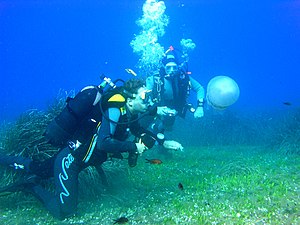 Scuba diving in Elba island, Italy (Photo credit: Wikipedia)
Scuba diving in Elba island, Italy (Photo credit: Wikipedia)
How can that be? This is because of the no decompression limits. It happens to all of us scuba divers. This is the interval that a diver may theoretically spend at a given depth without having to perform decompression stops. The no decompression limits helps divers plan dives so that they can stay at a given depth and ascend without stopping while avoiding significant risk of decompression sickness.
In 1985, Dick Rutkowski, started to introduce enriched air nitrox to the recreational diving community. This was a major movement that did not see any impact in the industry until the late 1990's. Even then training organizations, instructors and other divers in the community fought nitrox from becoming mainstream.
Nitrox reduces the proportions of nitrogen by increasing the proportion of oxygen, reducing the risk of decompression sickness for the same dive profile, or allows extended dive times without increasing the need for decompression stops for the same risk. In turn, nitrox allows us to stay longer and decreases our minimum surfaces.
Note: nitrox is not necessarily safer than air, although it can extend our bottom time and decrease surface intervals. Nitrox also has a risk of oxygen toxicity and if used incorrectly underwater you can increase the risk of convulsions due to the higher proportion of oxygen. This is why it is important to seek professional training and certification.
It's just like driving a car. Once you know the risk, and how do it properly, it can be very safe. Nitrox diving is the same. Once you learn and understand the risks you become a safer diver.
As a reward for becoming a safer diver, you can have the ability to stay longer underwater scuba diving and spend less time out of the water during a surface interval. Now go dive with nitrox!
Butch Zemar "Scuba Butch" is a scuba instructor that has been diving for over 15 years with well over 2,000 dives. He teaches entry level divers as well as instructors at a heated pool in Chicago. Trainers from around the nation come to train in Chicago, so why not train with the best? "Scuba is a romance and entertainment business. We increase communication and relationships through the enjoyment of recreational activities. Visit http://www.ScubaButch.com
Article Source: http://EzineArticles.com/?expert=Butch_Zemar
Article Source: http://EzineArticles.com/6910532
Kathy Dowsett
www.kirkscubagear.com

Scuba diving is a form of underwater diving.Scuba divers perform this task just for recreation and to explore the beautiful world that exists in the ocean waters.For diving oxygen set, the diver also has to wear swimfins on their feet for comfort swimming. FOr more details refer http://www.whatisall.com/games-and-sports/what-is-scuba-diving.html
ReplyDelete